View in other NatureServe Network Field Guides
NatureServe
Montana
Utah
Wyoming
Idaho
Wisconsin
British Columbia
South Carolina
Yukon
California
New York
Western Fence Lizard - Sceloporus occidentalis
Non-native Species
Global Rank:
G5
State Rank:
SNA
(see State Rank Reason below)
Agency Status
USFWS:
USFS:
BLM:
External Links
State Rank Reason (see State Rank above)
Species is nonnative/ introduced
General Description
EGGS:
The eggs are white, leathery, and oval. They are approximately 14 mm (0.5 in) long and 8 mm (0.3 in) wide. Clutch size is usually 4-17 eggs (averaging about 8). Clutches are laid in loose soil in shallow cavities (Nussbaum et al. 1983, Werner et al. 2004).
HATCHLINGS:
Hatchlings are 2.2-2.8 cm (0.87-1.1 in) snout-vent length (SVL), but otherwise adult-like in appearance. Hatchlings also lack yellow or orange on their legs. (St. John 2002, Stebbins 2003, Werner et al. 2004).
JUVENILES AND ADULTS:
The body is somewhat narrow and elongated. The back is grayish overall, and covered with pointed, keeled scales, giving the body a prickly appearance. There are 5-10 rows of dark brown or black, checkered or V-shaped, rows or bands running across the back. There may be a light-colored border to the back edges of the bars. Dark and light patches dot the sides of the body, and the rear surfaces of the legs have some pale yellow or orange coloration. There are large solid blue lateral abdominal patches, with a matching solid blue throat. Males have larger, more intense blue patches, sometimes lacking in females, and have black or dark gray bordering the blue areas. Young animals have little or no blue on the abdomen and throat, and are like females in coloration (St. John 2002, Stebbins 2003, Werner et al. 2004). Maximum SVL is about 9.5 cm (3.7 in) for both sexes. Maximum total length (TL) is approximately 18 cm (7.1 in), with the tail length about equal to the SVL. Mature females and males are roughly of equal size. (Davis 1967, Tanner and Hopkin 1972, Nussbaum et al. 1983, St. John 2002, Werner et al. 2004).
Diagnostic Characteristics
The Western Fence Lizard (
Sceloporus occidentalis) differs from the Common Sagebrush Lizard (
S. graciosus) by having a checkered pattern of darker triangular blotches in rows or bars across the back rather than pale dorsolateral stripes. The dorsal scales of the Common Sagebrush Lizard are also much less prickly and pointed. The blue throat patch in males is less pronounced than in the Western Fence Lizard. The Northern Alligator Lizard (
Elgaria coerulea) has a prominent skin fold on the side of the body and short legs. The Western Skink (
Plestiodon skiltonianus) has smooth, shiny, and flat dorsal scales. The juvenile and young adult skinks have conspicuous blue tails. Conversely, Western Fence Lizards have keeled scales that give the body a prickly appearance; the scales are not flattened and shiny, and they never have a blue tail. The Western Fence Lizard lacks the broad flattened body and fringe of prominent spines on each side of the body that are present in the Greater Short-horned Lizard (
Phrynosoma hernandesi) (St. John 2002, Stebbins 2003, Werner et al. 2004). Western Fence Lizard, Northern Alligator Lizard, and Western Skink are found only in northwestern Montana, west of the Continental Divide, while the Common Sagebrush Lizard and Greater Short-horned Lizard are present in Montana only east of the Divide (Maxell et al. 2003, Werner et al. 2004).
Species Range
Montana Range
Range Descriptions
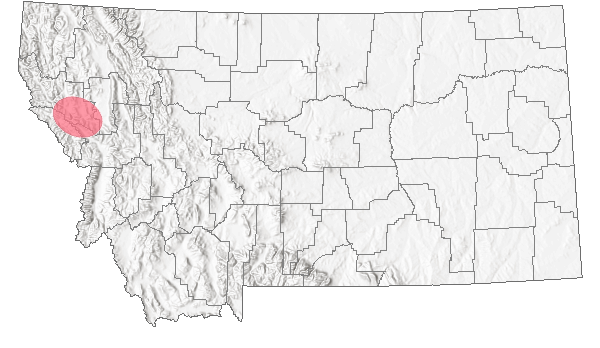
 Non-native
Non-native
Western Hemisphere Range
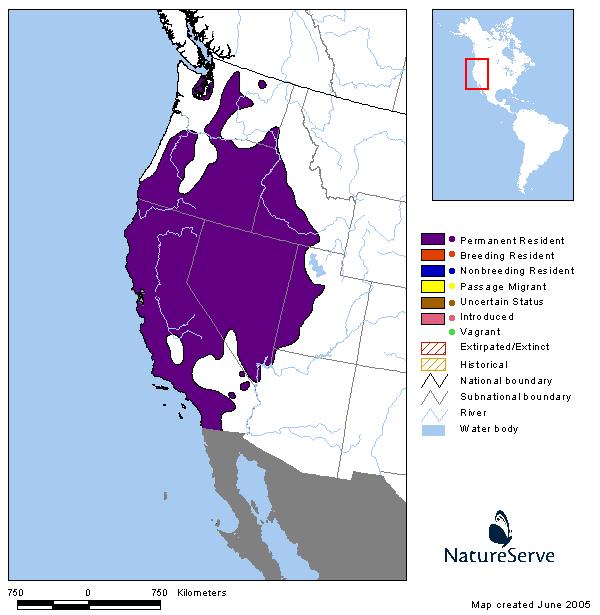
Range Comments
The Western Fence Lizard is a member of a large genus of North American lizards found from Panama to the Canadian border. The closest relatives include five additional species in the Udulatus group (Wiens and Reeder 1997). The Western Fence Lizard occurs from northern Washington, south through Oregon, southwestern Idaho, Nevada, western Utah, and most of California, into Mexico to northwestern Baja California. They are found at elevations from sea level in Washington, Oregon, and California to 3,300 m (10,800 ft) in California (Nussbaum et al. 1983, St. John 2002, Stebbins 2003). Six subspecies are currently recognized. The subspecies present in Montana is the Northwestern Fence Lizard (S. occidentalis occidentalis), which is found along the Cascade Mountains. A population was detected in 2002 by a biology student at the Salish Kootenai College along the lower Flathead River near Perma on the Flathead Indian Reservation in Sanders County (Werner et al. 2004, Werner 2008). The Montana population is isolated by about 240 km (149 miles) from the main range of the species located in eastern Washington (St. John 2002). It is unknown for certain whether this population is native or introduced, but it seems likely that it was an introduction via a train because a major rail line is immediately adjacent to the population and the population seems to be expanding (Werner 2008).
Maximum Elevation: 890 m (2,920 ft) in Sanders County by K. Werner (MTNHP POD 2023).
Observations in Montana Natural Heritage Program Database
Number of Observations: 13
(Click on the following maps and charts to see full sized version)
Map Help and Descriptions
Relative Density
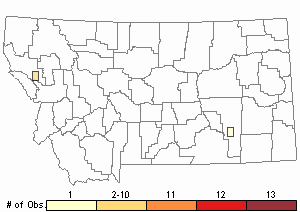
Recency
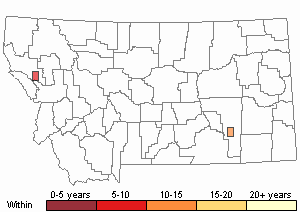


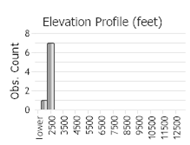 (Observations spanning multiple months or years are excluded from time charts)
(Observations spanning multiple months or years are excluded from time charts)
Habitat
The Western Fence Lizard is an animal of shrub-steppe habitats and open mixed deciduous and conifer forests, absent only from shady dense forest and extremely arid desert (Nussbaum et al. 1983, St. John 2002, Stebbins 2003). In northern California adults were often present in areas with some shade and in open pine forest under trees and shrubs (Manzanita,
Arctostaphylos), but also off the ground in trees and shrubs, and on or near rocks (Marcellini and Mackey 1970). Juveniles frequented grassy areas more than adults but climbed and were found less often under trees. All ages favor areas with rocks, fallen logs, and other objects upon which to bask or under for refuge. In central California, Western Fence Lizards tended to avoid grasslands but were present in low numbers in dense, short-stature oak woodlands. They were found to be more abundant in larger stature oak woodlands with grassland clearings and favored large-stature oak woodlands with large fallen logs and abundant downed wood (Davis and Ford 1983). In southern California, in an area of recently burned chaparral (
Quercus,
Adenostoma, and
Ceanothus), individuals were often found perching on charred branches, perhaps to enhance concealment from predators (Lillywhite and North 1974). In Nevada, Western Fence Lizards were found in areas of basalt cap rock dominated by piñon-juniper habitat with shallow soils, but also many rock outcrops; Oak (
Quercus sp.), Skunkbush (
Rhus trilobata), and Sagebrush (
Artemisia tridentata) were dominant shrubby species (Tanner and Hopkin 1972). Habitat use in Montana has not been the subject of study. The only known site along the Flathead River is an area of rocky terrain dominated by shrubby vegetation (Maxell et al. 2003, Werner et al. 2004, K. Werner personal communication). Favored areas throughout the range appear to have a high percentage of open bare ground and a component of low to tall shrubs or trees, as well as rocks and the presence of downed woody material. Although a ground dweller, the Western Fence Lizard will often perch above ground in low shrubs and trees; adults tend to perch higher than juveniles, and perch height is higher off the ground at lower elevation sites (Marcellini and Mackey 1970, Adolph 1990).
Ecological Systems Associated with this Species
- Details on Creation and Suggested Uses and Limitations
How Associations Were Made
We associated the use and habitat quality (common or occasional) of each of the 82 ecological systems mapped in Montana for
vertebrate animal species that regularly breed, overwinter, or migrate through the state by:
- Using personal observations and reviewing literature that summarize the breeding, overwintering, or migratory habitat requirements of each species (Dobkin 1992, Hart et al. 1998, Hutto and Young 1999, Maxell 2000, Foresman 2012, Adams 2003, and Werner et al. 2004);
- Evaluating structural characteristics and distribution of each ecological system relative to the species' range and habitat requirements;
- Examining the observation records for each species in the state-wide point observation database associated with each ecological system;
- Calculating the percentage of observations associated with each ecological system relative to the percent of Montana covered by each ecological system to get a measure of "observations versus availability of habitat".
Species that breed in Montana were only evaluated for breeding habitat use, species that only overwinter in Montana were only evaluated for overwintering habitat use, and species that only migrate through Montana were only evaluated for migratory habitat use.
In general, species were listed as associated with an ecological system if structural characteristics of used habitat documented in the literature were present in the ecological system or large numbers of point observations were associated with the ecological system.
However, species were not listed as associated with an ecological system if there was no support in the literature for use of structural characteristics in an ecological system,
even if point observations were associated with that system.
Common versus occasional association with an ecological system was assigned based on the degree to which the structural characteristics of an ecological system matched the preferred structural habitat characteristics for each species as represented in scientific literature.
The percentage of observations associated with each ecological system relative to the percent of Montana covered by each ecological system was also used to guide assignment of common versus occasional association.
If you have any questions or comments on species associations with ecological systems, please contact the Montana Natural Heritage Program's Senior Zoologist.
Suggested Uses and Limitations
Species associations with ecological systems should be used to generate potential lists of species that may occupy broader landscapes for the purposes of landscape-level planning.
These potential lists of species should not be used in place of documented occurrences of species (this information can be requested at:
mtnhp.mt.gov/requests) or systematic surveys for species and evaluations of habitat at a local site level by trained biologists.
Users of this information should be aware that the land cover data used to generate species associations is based on imagery from the late 1990s and early 2000s and was only intended to be used at broader landscape scales.
Land cover mapping accuracy is particularly problematic when the systems occur as small patches or where the land cover types have been altered over the past decade.
Thus, particular caution should be used when using the associations in assessments of smaller areas (e.g., evaluations of public land survey sections).
Finally, although a species may be associated with a particular ecological system within its known geographic range, portions of that ecological system may occur outside of the species' known geographic range.
Literature Cited
- Adams, R.A. 2003. Bats of the Rocky Mountain West; natural history, ecology, and conservation. Boulder, CO: University Press of Colorado. 289 p.
- Dobkin, D. S. 1992. Neotropical migrant land birds in the Northern Rockies and Great Plains. USDA Forest Service, Northern Region. Publication No. R1-93-34. Missoula, MT.
- Foresman, K.R. 2012. Mammals of Montana. Second edition. Mountain Press Publishing, Missoula, Montana. 429 pp.
- Hart, M.M., W.A. Williams, P.C. Thornton, K.P. McLaughlin, C.M. Tobalske, B.A. Maxell, D.P. Hendricks, C.R. Peterson, and R.L. Redmond. 1998. Montana atlas of terrestrial vertebrates. Montana Cooperative Wildlife Research Unit, University of Montana, Missoula, MT. 1302 p.
- Hutto, R.L. and J.S. Young. 1999. Habitat relationships of landbirds in the Northern Region, USDA Forest Service, Rocky Mountain Research Station RMRS-GTR-32. 72 p.
- Maxell, B.A. 2000. Management of Montana's amphibians: a review of factors that may present a risk to population viability and accounts on the identification, distribution, taxonomy, habitat use, natural history, and the status and conservation of individual species. Report to U.S. Forest Service Region 1. Missoula, MT: Wildlife Biology Program, University of Montana. 161 p.
- Werner, J.K., B.A. Maxell, P. Hendricks, and D. Flath. 2004. Amphibians and reptiles of Montana. Missoula, MT: Mountain Press Publishing Company. 262 p.
- Commonly Associated with these Ecological Systems
Grassland Systems
- Occasionally Associated with these Ecological Systems
Human Land Use
Food Habits
Adults and juveniles are “sit-and-wait” predators that hunt mainly by sight, but they also run and leap after flying insects (Tanner and Hopkin 1972). The diversity of food items taken indicates prey is taken largely opportunistically. Ants were the most abundant dietary items in Nevada (Tanner and Hopkin 1972), but beetles, Lepidoptera larvae, true flies, crickets and grasshoppers, true bugs, as well as spiders and the occasional scorpion, were taken. A similar diversity of arthropod prey is represented in stomach analyses of Western Fence Lizards from central and northern California, and southeastern Oregon (Johnson 1965, Rose 1976a, Whitaker and Maser 1981).
Ecology
Home ranges may be relatively small, with a maximum in Nevada of about 6,750 square meters (1.67 acres) for adult males and 1,950 square meters (0.48 acres) for adult females (Tanner and Hopkin 1972); mean home ranges for males and females, respectively, were 2,390 square meters (0.59 acres) and 385 square meters (0.095 acres). Mean home ranges for all age classes in central California were < 150 square meters (Davis and Ford 1983). Home range size among sites is influenced by habitat structure, among other factors, which differed greatly between the two cited studies.
Reproductive Characteristics
Across much of the range, eggs are laid during late April-July (Nussbaum et al. 1983, St. John 2002, Stebbins 2003). Egg laying in the laboratory by females from a moderate-elevation site in Nevada occurred in late June and early July (Tanner and Hopkin 1972), and a study female from a low-elevation site in southern California contained oviducal eggs from April to July (Goldberg 1973). Smaller females produce only 1-2 clutches per year, but larger females at low elevation sites may produce 3 clutches (Goldberg 1973). Clutch size can be as few as 4 eggs but as large as 15. The mean size of 15 clutches from Nevada was 11.2 eggs, with a range of 7-15 (Tanner and Hopkin 1972). Eggs hatch in 50-60 days, mostly in early to mid-August in Nevada and central California but continuing into late September in favorable years (Davis 1967, Tanner and Hopkin 1972, Nussbaum et al 1983). No information is available from Montana on any aspect of the reproductive biology of this species, although multiple age classes are present at the only occupied site, indicating successful reproduction has occurred (Maxell et al. 2003). Sexual maturity is attained in the spring of the second year, following the second hibernation (Tanner and Hopkin 1972, Nussbaum et al. 1983). Young adults breed and lay their first clutch when 21-23 months old. Mean annual survival rate of young and adults is probably quite variable; in Nevada, survival of marked juveniles was estimated to be about 28% (Tanner and Hopkin 1972). Males and females in central California and Nevada can live to five or more years (Davis 1967, Tanner and Hopkins 1972).
Management
The following was taken from the Status and Conservation section for the Western Fence Lizard account in
Maxell et al. 2009.
At the time the comprehensive summaries of amphibians and reptiles in Montana (Maxell et al. 2003, Werner et al. 2004) were published, there was only one documented site in Montana for Western Fence Lizard, discovered in 2002 near Perma, Sanders County. This remains the only documented population as of 2008 (Werner 2008). The Montana population is isolated by about 250 m (150 mi) from the nearest populations in Washington and Idaho. It seems likely that the population was introduced via a train because a major rail line is immediately adjacent to the population and the population seems to be expanding (Werner 2008). Another indication that this population is not native is the fact that an earlier survey of the Flathead Indian Reservation (Werner et al. 1998a) failed to document this lizard species, even though several of the survey sites were in the Lower Flathead River area. Additional surveys along the lower Flathead River and genetic evaluation of the population to determine its status as native or introduced are both important conservation measures that need to be taken. If the population is introduced, control measures should be enacted as soon as possible while the population is small. If the population is determined to possibly be native, then protective measures should be put in place as soon as possible. Few studies address or identify risk factors. Western Fence Lizard can persist in recently burned chaparral areas (Lillywhite and North 1974), indicating a level of tolerance for extreme habitat disturbance. However, alterations to rangelands could influence grass and exotic weed encroachment, which could increase the deleterious effects of fire on Western Fence Lizard populations. Their preference for rocky sites could help buffer them from some negative effects of fire. Use of chemical pest control agents for weeds and insects could negatively impact directly or indirectly their preferred arthropod prey.
Stewardship Responsibility
References
- Literature Cited AboveLegend:
 View Online Publication
View Online Publication Adolph, S.C. 1990b. Perch height selection by juvenile Sceloporus lizards: Interspecific differences and relationship to habitat use. Journal of Herpetology 24(1): 69-75.
Adolph, S.C. 1990b. Perch height selection by juvenile Sceloporus lizards: Interspecific differences and relationship to habitat use. Journal of Herpetology 24(1): 69-75. Davis, J. 1967. Growth and size of the western fence lizard (Sceloporus occidentalis). Copeia 1967: 721-731.
Davis, J. 1967. Growth and size of the western fence lizard (Sceloporus occidentalis). Copeia 1967: 721-731. Davis, J. and R. G. Ford. 1983. Home range in the western fence lizard (Ssceloporus occidentalis occidentalis). Copeia 1983: 933-940.
Davis, J. and R. G. Ford. 1983. Home range in the western fence lizard (Ssceloporus occidentalis occidentalis). Copeia 1983: 933-940. Goldberg, S.R. 1973. Ovarian cycle of the western fence lizard, Sceloporus occidentalis. Herpetologica 29:284-289.
Goldberg, S.R. 1973. Ovarian cycle of the western fence lizard, Sceloporus occidentalis. Herpetologica 29:284-289. Johnson, C.R. 1965. The diet of the Pacific fence lizard, Sceloporus occidentalis occidentalis (Baird and Girard), from Northern California. Herpetologica 21: 114-117.
Johnson, C.R. 1965. The diet of the Pacific fence lizard, Sceloporus occidentalis occidentalis (Baird and Girard), from Northern California. Herpetologica 21: 114-117. Lillywhite, H.B. and F. North. 1974. Perching behavior of Sceloporus occidentalis in recently burned Chaparral. Copeia 1974(1): 256-257.
Lillywhite, H.B. and F. North. 1974. Perching behavior of Sceloporus occidentalis in recently burned Chaparral. Copeia 1974(1): 256-257. Marcellini, D. and J.P. Mackey. 1970. Habitat preferences of the lizards Sceloporus occidentalis and S. graciosus (Lacertilia, Iguanidae). Herpetologica 26: 51-56.
Marcellini, D. and J.P. Mackey. 1970. Habitat preferences of the lizards Sceloporus occidentalis and S. graciosus (Lacertilia, Iguanidae). Herpetologica 26: 51-56. Maxell, B.A., J.K. Werner, P. Hendricks, and D.L. Flath. 2003. Herpetology in Montana: a history, status summary, checklists, dichotomous keys, accounts for native, potentially native, and exotic species, and indexed bibliography. Society for Northwestern Vertebrate Biology, Northwest Fauna Number 5. Olympia, WA. 135 p.
Maxell, B.A., J.K. Werner, P. Hendricks, and D.L. Flath. 2003. Herpetology in Montana: a history, status summary, checklists, dichotomous keys, accounts for native, potentially native, and exotic species, and indexed bibliography. Society for Northwestern Vertebrate Biology, Northwest Fauna Number 5. Olympia, WA. 135 p. Maxell, B.A., P. Hendricks, M.T. Gates, and S. Lenard. 2009. Montana amphibian and reptile status assessment, literature review, and conservation plan, June 2009. Montana Natural Heritage Program. Helena, MT. 643 p.
Maxell, B.A., P. Hendricks, M.T. Gates, and S. Lenard. 2009. Montana amphibian and reptile status assessment, literature review, and conservation plan, June 2009. Montana Natural Heritage Program. Helena, MT. 643 p. Nussbaum, R.A., E.D. Brodie, Jr. and R.M. Storm. 1983. Amphibians and reptiles of the Pacific Northwest. University of Idaho Press. Moscow, ID. 332 pp.
Nussbaum, R.A., E.D. Brodie, Jr. and R.M. Storm. 1983. Amphibians and reptiles of the Pacific Northwest. University of Idaho Press. Moscow, ID. 332 pp. Rose, B.R. 1976a. Dietary overlap of Sceloporus occidentalis and S. gracious. Copeia 1976: 818-820.
Rose, B.R. 1976a. Dietary overlap of Sceloporus occidentalis and S. gracious. Copeia 1976: 818-820. St. John, A.D. 2002. Reptiles of the northwest: California to Alaska, Rockies to the coast. Lone Pine Publishing, Renton, WA. 272 p.
St. John, A.D. 2002. Reptiles of the northwest: California to Alaska, Rockies to the coast. Lone Pine Publishing, Renton, WA. 272 p. Stebbins, R. C. 2003. A field guide to western reptiles and amphibians. 3rd Edition. Houghton Mifflin Company, Boston and New York. 533 p.
Stebbins, R. C. 2003. A field guide to western reptiles and amphibians. 3rd Edition. Houghton Mifflin Company, Boston and New York. 533 p. Tanner, W.W., and J.M. Hopkin. 1972. Ecology of Sceloporus occidentalis longipes Baird and Uta stansburiana Baird and Girar on Rainier Mesa, Nevada Test Site, Nye County, Nevada. Brigham Young University Science Bulletin, Biological Series Volume 15, No. 4.
Tanner, W.W., and J.M. Hopkin. 1972. Ecology of Sceloporus occidentalis longipes Baird and Uta stansburiana Baird and Girar on Rainier Mesa, Nevada Test Site, Nye County, Nevada. Brigham Young University Science Bulletin, Biological Series Volume 15, No. 4. Werner, J.K. 2008. Status of the western fence lizard in Montana. Abstract. 2008 JointMeetings of the Society for Northwestern Vertebrate Biology, Montana Chapter of the Wildlife Society, and Partners for Amphibian and Reptile Conservation. Missoula, MT. February 25-29, 2008.
Werner, J.K. 2008. Status of the western fence lizard in Montana. Abstract. 2008 JointMeetings of the Society for Northwestern Vertebrate Biology, Montana Chapter of the Wildlife Society, and Partners for Amphibian and Reptile Conservation. Missoula, MT. February 25-29, 2008. Werner, J.K., B.A. Maxell, P. Hendricks and D.L. Flath. 2004. Amphibians and Reptiles of Montana. Mountain Press Publishing Company: Missoula, MT. 262 pp.
Werner, J.K., B.A. Maxell, P. Hendricks and D.L. Flath. 2004. Amphibians and Reptiles of Montana. Mountain Press Publishing Company: Missoula, MT. 262 pp. Werner, J.K., T. Plummer, and J. Weaslehead. 1998a. Amphibians and reptiles of the Flathead Indian Reservation. Intermountain Journal of Sciences 4(1-2): 33-49.
Werner, J.K., T. Plummer, and J. Weaslehead. 1998a. Amphibians and reptiles of the Flathead Indian Reservation. Intermountain Journal of Sciences 4(1-2): 33-49. Whitaker, J.O. Jr. and C. Maser. 1981. Food habits of seven species of lizards from Malheur County, southeastern Oregon. Northwest Science 55(3): 202-208.
Whitaker, J.O. Jr. and C. Maser. 1981. Food habits of seven species of lizards from Malheur County, southeastern Oregon. Northwest Science 55(3): 202-208. Wiens, J.J. and T.W. Reeder. 1997. Phylogeny of the spiny lizards (Sceloporus) based on molecular and morphological evidence. Herpetological Monographs 11:1-101.
Wiens, J.J. and T.W. Reeder. 1997. Phylogeny of the spiny lizards (Sceloporus) based on molecular and morphological evidence. Herpetological Monographs 11:1-101.
- Additional ReferencesLegend:
 View Online Publication
View Online Publication
Do you know of a citation we're missing? Joslin, Gayle, and Heidi B. Youmans. 1999. Effects of recreation on Rocky Mountain wildlife: a review for Montana. [Montana]: Montana Chapter of the Wildlife Society.
Joslin, Gayle, and Heidi B. Youmans. 1999. Effects of recreation on Rocky Mountain wildlife: a review for Montana. [Montana]: Montana Chapter of the Wildlife Society.
- Web Search Engines for Articles on "Western Fence Lizard"
- Additional Sources of Information Related to "Reptiles"





